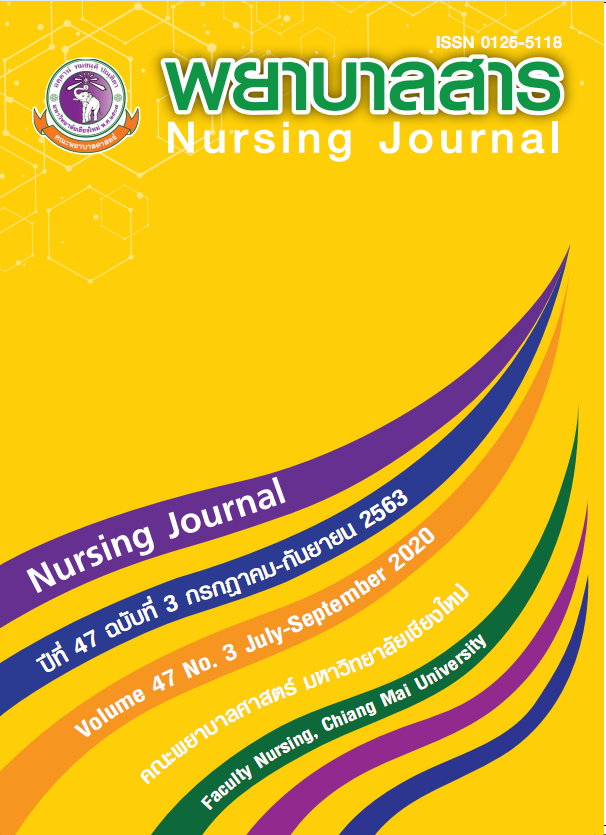Factors Related to Fatigue Among Expectant Fathers Having Wives with High-risk Pregnancy
Keywords:
Anxiety, Social support, Fatigue, Expectant father, Wives with a high-risk pregnancyAbstract
Expectant fathers whose wives have high-risk pregnancies, report experiencing fatigue which causes physical and mental health problems. The aim of this descriptive correlation research was to study the relationship between anxiety, social support and fatigue amongst this particular group. Suitable participants were identified in the antenatal care unit at Maharaj Nakorn Chiang Mai Hospital and Chiang Mai Health Promotion Center Region 1 between 1st February 2018 and 4th May 2018. Purposive sampling was used to recruit 85 participants with relevant inclusion criteria for this study. The research tools were The Modified Fatigue Symptoms by Pugh, Milligan, Parks, Lenz, & Kitzmen (1999), translated into Thai by Theerakulchai (2004); the State-Trait Anxiety Inventory [STAI] form Y-1 by Spielberger (1983), translated into Thai by Nontasak, Aemsupasit and Thapinta (1991); and the Social Support questionnaire for expectant fathers of high-risk pregnant wives by Naewchalee (2007). Descriptive statistics and Pearson's correlation coefficient were used to analyze the data.
The results of the study revealed that the majority of expectant fathers (76.47%) had low fatigue, 21.18% had moderate fatigue, and 2.35% had high fatigue. Their average score of fatigue was 51.57 (S.D. = 15.36). Anxiety had a positive correlation with fatigue in this expectant father group (r = .468, p < .01). Social support had a negative correlation for them with fatigue (r = -.236, p < .05).
The results of the study can be used to help nurse practitioners to pay attention to fatigue with associated anxiety and lack of social support among these expectant fathers with high risk pregnant wives.
References
Bourrier, D. (1999). Childbirth expectations in a complicated pregnancy: The father’s perspective(Master's thesis, University of Manitoba).
Daniel, C. (2007). Interview-A naturopath’s perspective on a father’s role in pregnancy & childbirth. Retrieved from http://natural-fertility-info.com/a-fathers-rol e-in-pregnancy-childbirth.html
Department of health. (2012). Happy to be a father. Retrieved from http://thailand.unfpa.org/ sites/ default/files/pub-pdf/DadHandbook.pdf
Elek, S. M., Hudson, D. B., & Fleck, M. O. (2002). Couples’ experiences with fatigue during the transition to parenthood. Journal of Family Nursing, 8 (3), 221-240.
Faye, G. (2008). Mental health concerns for women in adolescence and adulthood. Wolters Kluwer: Lippincott Williams & Wilkins.
Gay, C. L., Lee, K. A., & Lee, S. Y. (2004). Sleep patterns and fatigue in new mothers and father.Biological Research for Nursing, 5(4), 311-318. doi:https://dx.doi.org/10.1177%2F1099800403262142" t "pmc_ext"
Gray, J. R., Glove, S. K., & Sutherland, S. (2017). The practice of nursing research: Appraisal,synthesis, and generation of evidence (8th ed.). St. Louis: Saunders.
Hart, L., Freel, M., & Milde, F. (1990). Fatigue. Nursing Clinics of North America, 25, 967-976.
House, J. S. (1981). Work stress and social support. Mass: Addison-Wesley.
Kanjanakeaw, A. (2017). Factors related to anxiety of first-time Fathers (Master's thesis, Chiang Mai University).
Loutzenhiser, L., Mcauslan, P., & Sharpe, D. P. (2015). The trajectory of maternal and paternal fatigueand factors associated with fatigue across the transition to parenthood. Clinical Psychologist,19 (1), 15-27. doi:10.1111/cp.12048
Maloni, J. A., Brezinski-Tomasi, J. E., & Johnson, L. A. (2001). Antepartum bed rest: Effect upon the family. Journal of Obstetric, Gynecological and Neonatal Nursing, 30(2), 165-173. doi:10.1111/j.1552-6909.2001.tb01532.x
Naewchalee, A. (2007). The predictability of personal factors, social support and uncertainty on stress and coping behavior of first-time fathers from high risk pregnancy (Master's thesis, Mahidol University).
Onpiw, N. (2017). Factors related to fatigue among fathers in postnatal period (Master's thesis, Chiang Mai University).
Piper, B. F. (2003). Fatigue. In V., Carrieri-Kohlman, A. M., Li ndsey, C. M., West, & E. F., Bond (Eds.), Pathophysiological phenomena in nursing: Human responses to illness. St. Louis: Saunders.
Polit, D. F. (2010). Statistics and data analysis for nursing research (2nd ed.). New Jersey: Pearson Education Inc.
Pugh, L. C., & Milligan, R. (1993). A framework for the study of childbearing fatigue. Advances in Nursing Science, 15 (4), 60-70.
Pugh, L. C., & Milligan, R., Parks, P. L., Lenz, E. R., & Kitzman, H. (1999). Clinical approaches in theassessment of childbearing fatigue. Journal of Obstetric, Gynecologic, & Neonatal Nursing,28 (1), 74-80.
Teixeira, C., Figueiredo, B., Conde, A., Pacheco, A., & Costa, R. (2009). Anxiety and depression duringpregnancy in women and men. Journal of Affective Disorders, 199 (1), 142-148. doi:10.1016/j.jad.2009.03.005
Thapinta, D. (1991). Reduction of anxiety of staff nurses working with AIDS patients throughcognitive reconstructuring and mindfulness training (Master's thesis, Chulalongkorn University).
Theerakulchai, J. (2004). Factors related to fatigue and fatigue management among Thai postpartumwomen (Doctoral dissertation, Chiang Mai).
Rodrigues, P. B., Zambaldi, C. F., Cantilino, A., & Sougey, E, B. (2016). Special feates of high-risk pregnancies as factors in development of mental distress: A review. Trends in Psychiatry Psychotherapy, 38 (3), 136-140. doi:10.1590/2237-6089-2015-0067
Sansiriphun, N., Kantaruksa, K., Klunklin, A., Baosuang, C., & Jordan, P. (2010). Thai men becoming a first-time father. Nursing and Health Sciences, 12 (4), 403-409.
Spielberger, C. D. (1976). The nature and measurement of anxiet y. In C. D. Spielberger, & R.Diaz-Guerrero (Eds.), Cross-cultural anxiety (pp. 3-12). Washing: Hemisphere.
Spielberger, C. D., Gorsuch, R. L., Lushene, R., Vagg, P. R., & Jacobs, G. A. (1983). Manual for the State-Trait Anxiety Inventory. Palo Alto, CA: Consulting Psychologists Press.
Widarsson, M., Kerstis, B., Sundquist, K., Engstrom, G., & Sarkadi. (2012). Support needs of expectantmothers and fathers: A qualitative study. The Journal of Perinatal Education, 21 (1), 36-44.doi:10.1891/ 1058-1243.21.1.36
Downloads
Published
How to Cite
Issue
Section
License
บทความที่ได้รับการตีพิมพ์เป็นลิขสิทธิ์ของวารสารพยาบาลสาร
ข้อความที่ปรากฏในบทความแต่ละเรื่องในวารสารวิชาการเล่มนี้เป็นความคิดเห็นส่วนตัวของผู้เขียนแต่ละท่านไม่เกี่ยวข้องกับมหาวิทยาลัยเชียงใหม่ และคณาจารย์ท่านอื่นๆในมหาวิทยาลัยฯ แต่อย่างใด ความรับผิดชอบองค์ประกอบทั้งหมดของบทความแต่ละเรื่องเป็นของผู้เขียนแต่ละท่าน หากมีความผิดพลาดใด ๆ ผู้เขียนแต่ละท่านจะรับผิดชอบบทความของตนเองแต่ผู้เดียว






